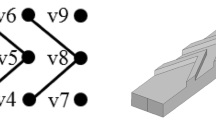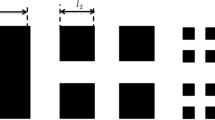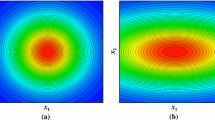Abstract
Surrogate models have been applied to shape optimizations of a micromixer with the aim of assessing the performance of the models. The surrogate models considered include polynomial response surface approximation, Kriging, and radial basis neural network. In addition, a weighted average model based on global error measures is constructed. A mixing index at the exit of the micromixer is used as the objective function. The mixing index is calculated based on Navier-Stokes equations. Two cases of optimization, one with two design variables and the other with three design variables, have been tested. The design variables are selected among the ratio of the groove depth to channel height, the angle of groove, and the ratio of groove width to groove pitch. D-Optimal design generated sampling points are used for sampling. It is found that although the weighted average model does not predict the best optimal point, it does show consistent and reliable performance.
Similar content being viewed by others
References
N. V. Queipo, R. T. Haftka, W. Shyy, T. Goel, R. Vaidyanathan and P. K. Tucker, Surrogate-based analysis and optimization, Prog. in Aerospace. Sci. 41 (2005) 1–28.
W. Li and S. Padula, Approximation methods for conceptual design of complex systems, Eleventh International Conference on Approximation Theory (eds. C. Chui, M. Neaumtu, L. Schumaker) (2004) 241–278.
L. Zerpa, N. V. Queipo, S. Pintos and J. Salager, An optimization methodology of alkaline-surfactantpolymer flooding processes using field scale numerical simulation and multiple surrogates, J. of Petroleum Sci. and Eng. 47 (2005) 197–208.
T. Goel, R. Haftka, W. Shyy and N. Queipo, Ensemble of surrogates, Struct. and Multidisciplinary Optimization, 33 (3) (2007) 199–216.
T. Goel, J. Zhao, S. Thakur, R. T. Haftka and W. Shyy, Surrogate model-based strategy for cryogenic cavitation model validation and sensitivity evaluation, 42nd AIAA/ASME/ SAE/ASEE Joint Propulsion Conference and Exhibit, Sacramento, USA. AIAA (2006) 2006–5047.
A. D. Stroock, S. K. W. Dertinger, A. Ajdari, I. Mezic, H. A. Stone and G. M. Whitesides, Chaotic mixer for microchannels. Science 295 (2002) 647–651.
V. Hessel, H. Lowe and F. Schonfeld, 2005, Micromixers-a review on passive and active mixing principles. Chem. Eng. Sci. 60 (2005) 2479–2501.
A. D. Stroock and G. J. McGraw, Investigation of the staggered herringbone mixer with a simple analytical model. Philos. Trans. R. Soc. London, Ser. A, 362 (2004) 971–986.
J. Aubin, D. F. Fletcher, J. Bertrand and C. Xuereb, Characterization of the mixing quality in micromixers. Chem. Eng. Tech. 26 (12) (2003) 1262–1270.
D. G. Hassel and W. B. Zimmerman, Investigation of the convective motion through a staggered herringbone micromixer at low Reynolds number flow. Chem. Eng. Sci. 61 (2006) 2977–2985.
G. N. Vanderplaats, Numerical optimization techniques for engineering design with applications, McGraw-Hill, 1984.
M. A. Ansari and K. Y. Kim, Application of radial basis neural network to optimization of a micromixer. Chem. Eng. Tech. 30 (7) (2007) 962–966.
CFX-10.0, Solver Theory, ANSYS 2004.
MATLAB®, The language of technical computing, Release 14, The MathWorks Inc.
R. H. Myers and D. C. Montgomery, Response surface methodology: process and product optimization using designed experiment, Wiley, New York, (1995).
M. L. J. Orr, Centre for Cognitive Science, Edinburgh University, EH 9LW, Scotland, UK, (http://anc.ed.ac.uk/rbf/rbf.html), (1996).
J. D. Martin and T. W. Simpson, Use of kriging models to approximate deterministic computer models. AIAA Journal 43 (4) (2005) 853–863.
A. Samad, K. Y. Kim, T. Goel, R. T. Haftka and W. Shyy, Shape optimization of turbomachinery blade using multiple surrogate models, 10th International Symposium on Advances in Numerical Modeling of Aerodynamics and Hydrodynamics in Turbomachinery, ASME Joint-U.S.-European Fluids Engineering Summer Meeting, Miami, FL, USA, FEDSM2006-98368.
Author information
Authors and Affiliations
Corresponding author
Rights and permissions
About this article
Cite this article
Ansari, M.A., Kim, KY. Evaluation of surrogate models for optimization of herringbone groove micromixer. J Mech Sci Technol 22, 387–396 (2008). https://doi.org/10.1007/s12206-007-1035-4
Received:
Revised:
Accepted:
Published:
Issue Date:
DOI: https://doi.org/10.1007/s12206-007-1035-4




